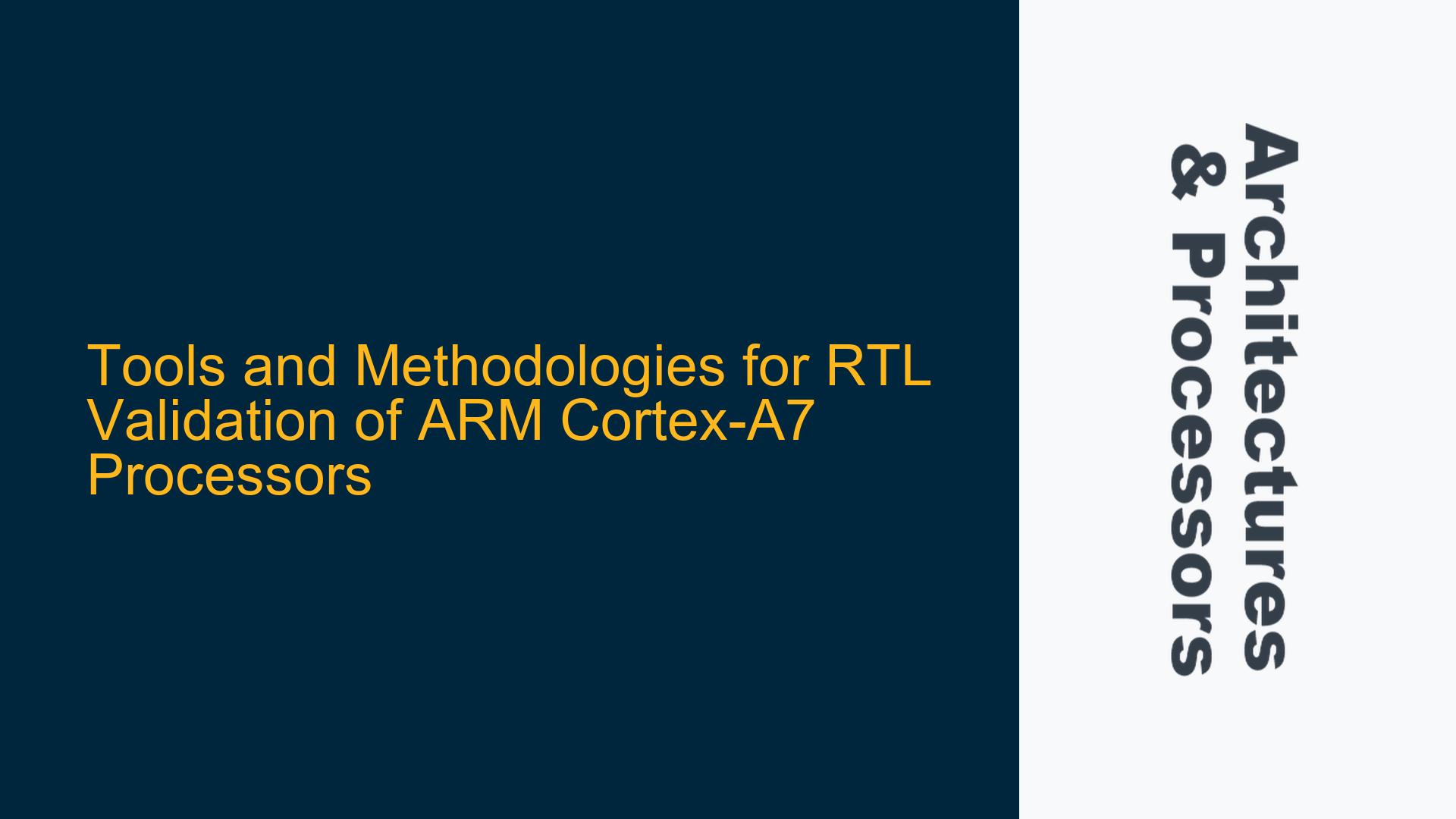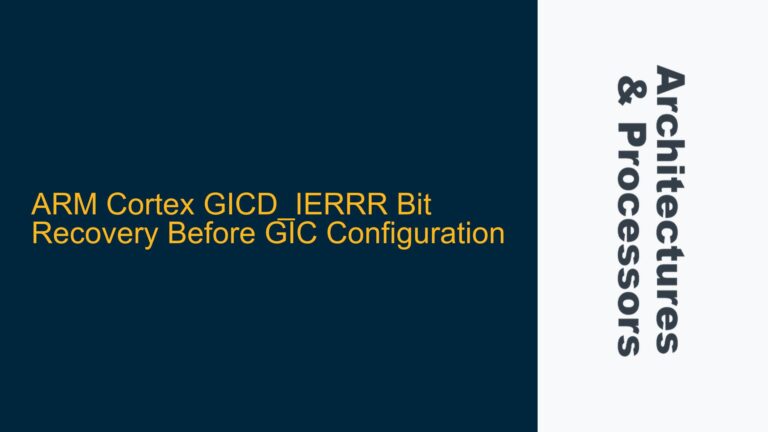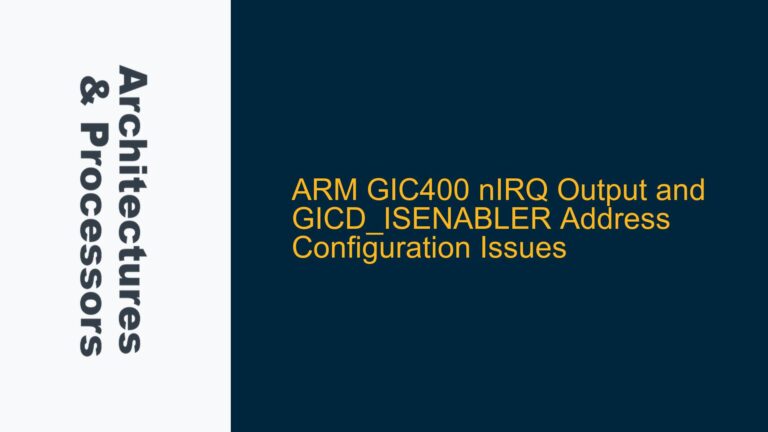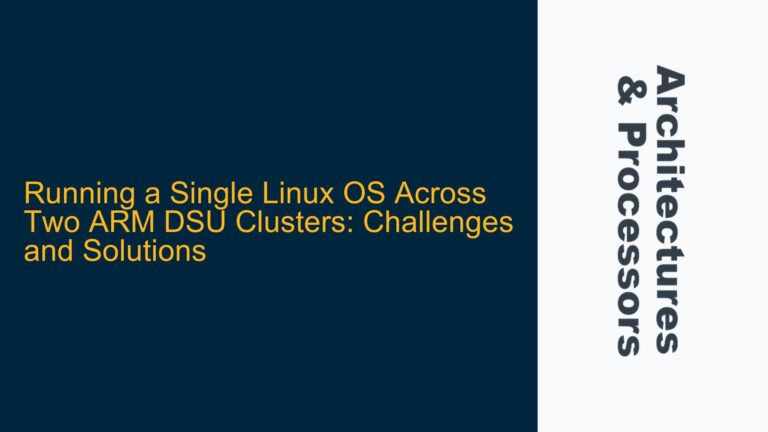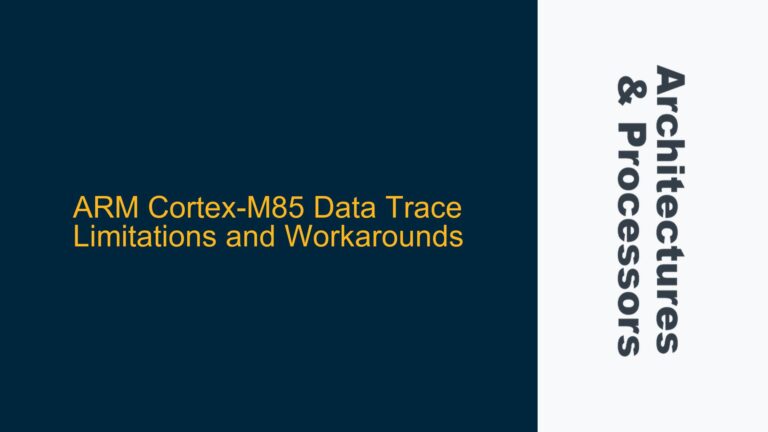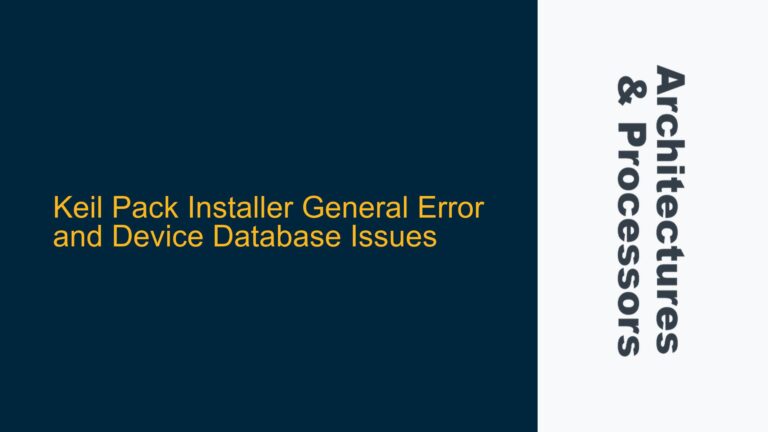ARM Cortex-A7 RTL Validation: Understanding the Scope and Requirements
RTL (Register Transfer Level) validation is a critical phase in the development of any processor, including the ARM Cortex-A7. The Cortex-A7 is a highly efficient processor core designed for low-power applications, often used in embedded systems, mobile devices, and IoT applications. RTL validation ensures that the design of the processor adheres to its architectural specifications and performs as expected under various conditions. This process involves simulating the RTL code, which describes the digital circuitry of the processor, to verify its functionality, performance, and compliance with the ARM architecture.
The Cortex-A7 core is part of ARM’s Cortex-A series, which is based on the ARMv7-A architecture. This architecture includes features such as Thumb-2 instruction set, NEON SIMD (Single Instruction Multiple Data) for multimedia processing, and a Memory Management Unit (MMU) for virtual memory support. Given the complexity of the Cortex-A7, RTL validation requires a comprehensive set of tools and methodologies to ensure that all aspects of the processor are thoroughly tested.
The primary goal of RTL validation is to identify and resolve any design errors before the processor is fabricated. This involves running a series of tests that cover various scenarios, including normal operation, edge cases, and error conditions. The validation process also includes performance analysis to ensure that the processor meets its timing and power requirements. Given the importance of this phase, it is essential to use the right tools and techniques to achieve accurate and reliable results.
Essential Tools for ARM Cortex-A7 RTL Validation
The RTL validation of the ARM Cortex-A7 processor requires a combination of tools that cover different aspects of the validation process. These tools can be broadly categorized into simulation tools, verification IP (Intellectual Property), and debugging tools. Each of these categories plays a crucial role in ensuring that the RTL code is thoroughly tested and validated.
Simulation tools are used to model the behavior of the Cortex-A7 processor at the RTL level. These tools allow engineers to run test cases and observe the behavior of the processor under different conditions. Some of the most commonly used simulation tools for ARM processors include Synopsys VCS, Cadence Xcelium, and Mentor Graphics Questa. These tools provide a high level of accuracy and performance, making them suitable for large and complex designs like the Cortex-A7.
Verification IP (VIP) is another critical component of the RTL validation process. VIP provides pre-verified models of standard interfaces and protocols, which can be used to test the interaction between the Cortex-A7 processor and other components in the system. ARM provides a range of VIP for its processors, including AMBA (Advanced Microcontroller Bus Architecture) VIP, which is used to validate the AXI (Advanced eXtensible Interface) and AHB (Advanced High-performance Bus) interfaces. These VIPs help ensure that the processor communicates correctly with other components in the system.
Debugging tools are essential for identifying and resolving issues that arise during the RTL validation process. These tools allow engineers to trace the execution of the RTL code, set breakpoints, and inspect the state of the processor at different points in time. ARM’s DS-5 Development Studio is a popular debugging tool for ARM processors, providing a comprehensive set of features for debugging and performance analysis. Other tools, such as Lauterbach TRACE32 and Segger J-Link, are also widely used in the industry.
In addition to these tools, it is also important to use a version control system to manage the RTL code and test cases. Git is a commonly used version control system that allows engineers to track changes, collaborate with team members, and maintain a history of the design. This is particularly important in large projects where multiple engineers are working on different parts of the design.
Best Practices for ARM Cortex-A7 RTL Validation
The RTL validation of the ARM Cortex-A7 processor is a complex and time-consuming process that requires careful planning and execution. To ensure that the validation process is effective, it is important to follow best practices that have been proven to work in the industry. These best practices cover various aspects of the validation process, including test case development, simulation, debugging, and performance analysis.
One of the most important best practices is to develop a comprehensive set of test cases that cover all aspects of the processor’s functionality. This includes normal operation, edge cases, and error conditions. The test cases should be designed to exercise all parts of the RTL code, including the instruction set, memory interfaces, and peripherals. It is also important to include stress tests that push the processor to its limits, such as high clock speeds, heavy workloads, and extreme temperatures.
Another best practice is to use a combination of directed and random testing. Directed testing involves running specific test cases that target particular features or functions of the processor. Random testing, on the other hand, involves generating random inputs and observing the behavior of the processor. This approach helps uncover issues that may not be apparent in directed testing, such as timing violations and race conditions.
Simulation is a critical part of the RTL validation process, and it is important to use the right simulation tools and techniques. One best practice is to use a cycle-accurate simulator, which models the behavior of the processor at the clock cycle level. This provides a high level of accuracy and helps identify timing issues that may not be apparent in a higher-level simulation. It is also important to run simulations on a variety of platforms, including different operating systems and hardware configurations, to ensure that the RTL code is portable and robust.
Debugging is another important aspect of the RTL validation process, and it is essential to use the right tools and techniques. One best practice is to use a combination of hardware and software debugging tools. Hardware debugging tools, such as JTAG (Joint Test Action Group) probes, allow engineers to inspect the state of the processor in real-time. Software debugging tools, such as ARM’s DS-5 Development Studio, provide a high level of visibility into the RTL code and allow engineers to set breakpoints, inspect variables, and trace the execution of the code.
Performance analysis is also a critical part of the RTL validation process, and it is important to use the right tools and techniques. One best practice is to use performance counters, which are built into the Cortex-A7 processor, to measure various aspects of the processor’s performance, such as clock cycles, cache hits, and memory accesses. This data can be used to identify performance bottlenecks and optimize the RTL code. It is also important to use profiling tools, such as ARM’s Streamline Performance Analyzer, to analyze the performance of the processor in real-world applications.
Finally, it is important to document the RTL validation process and results. This includes documenting the test cases, simulation results, debugging findings, and performance analysis. This documentation provides a record of the validation process and helps ensure that the processor meets its design specifications. It also provides valuable information for future projects and helps improve the overall quality of the design.
Implementing a Robust RTL Validation Strategy for ARM Cortex-A7
Implementing a robust RTL validation strategy for the ARM Cortex-A7 processor requires a combination of tools, techniques, and best practices. The first step is to define the scope of the validation process, including the features and functions that need to be tested. This includes the instruction set, memory interfaces, peripherals, and any custom features that have been added to the design.
Once the scope has been defined, the next step is to develop a comprehensive set of test cases that cover all aspects of the processor’s functionality. This includes normal operation, edge cases, and error conditions. The test cases should be designed to exercise all parts of the RTL code, including the instruction set, memory interfaces, and peripherals. It is also important to include stress tests that push the processor to its limits, such as high clock speeds, heavy workloads, and extreme temperatures.
The next step is to set up the simulation environment, including the simulation tools, verification IP, and debugging tools. The simulation environment should be configured to run the test cases and provide detailed feedback on the behavior of the processor. This includes running simulations on a variety of platforms, including different operating systems and hardware configurations, to ensure that the RTL code is portable and robust.
Once the simulation environment is set up, the next step is to run the test cases and analyze the results. This includes running directed and random tests, using cycle-accurate simulation, and using hardware and software debugging tools to identify and resolve issues. It is also important to use performance counters and profiling tools to analyze the performance of the processor and identify any bottlenecks.
Finally, it is important to document the RTL validation process and results. This includes documenting the test cases, simulation results, debugging findings, and performance analysis. This documentation provides a record of the validation process and helps ensure that the processor meets its design specifications. It also provides valuable information for future projects and helps improve the overall quality of the design.
In conclusion, the RTL validation of the ARM Cortex-A7 processor is a complex and time-consuming process that requires careful planning and execution. By using the right tools, techniques, and best practices, engineers can ensure that the processor is thoroughly tested and validated, and that it meets its design specifications. This not only helps ensure the success of the current project but also provides valuable insights and lessons for future projects.
